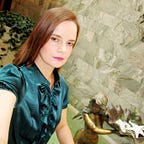The Red Hibiscus: Anthology Vol.21 Preface
The beauties and mysteries of nature trickle down from mind and scribble poetically on a blank slate. This flow clears the clogged mind promising paradisiacal peace within. Creativity burns negative thoughts and fills life with colourful imageries. Let the striking depictions of thoughts reach the vivacious souls and create a niche of its own.
(Kamala Ajith)
On May 11 New Moon the Lights were conjunct Caput Algol. The star Algol takes its name from an Arabic word meaning “the Demon’s Head.” This star is said to depict the terrifying snaky head of the Medusa monster whose story is closely related to another mythological figure, Athena. In the mythology of the skies, Perseus — a great hero often depicted mounted on Pegasus the Flying Horse — used Medusa’s head to his own advantage — to turn Cetus the Sea-monster into stone. Algol is a known variable star, which waxes and wanes in brightness.
There are many variable stars known throughout the heavens, but Algol might well be the most famous variable star of them all. This star brightens and dims with clockwork regularity, completing one cycle in two days, 20 hours, and 49 minutes. Plus its entire cycle is visible to the eye alone. The early stargazers surely knew about its changing brightness and must have smiled as they named variable Algol — a strangely behaving star in a sky full of steadily shining stars — for a mythological demon. The ancients explained this phenomenon as the winking of the demon’s eye still blinking after her body had been decapitated. However in the pre-Hellenic accounts of the Medusa story, Pallas-Athena and Medusa were actually harmonious and parts of the same beautiful triple Goddess. Indeed I remember seeing Medusa depicted above the entrance of every Apollo temple I’ve visited in Asia Minor.
Interestingly, I dreamed I was a great royal who was ritually beheaded and my consciousness survived the ceremony a few days before that celestial event. Recent studies also claim the Algol was represented as Horus by ancient Egyptian astrologers, and signified divinity and kingship.
In Volume 21, Yanne Cyris from sunny Saint Lucia explores the healing nature of light and how it can transform our consciousness in Shine Your Light Brightly. It is the same doctrine of the spiritual good, purity, illumination and truth that Pallas Athene — Minerva represented to the ancients.
The etymology of her names, — Pallas Athene, and Minerva, — must still be considered as unknown or at least doubtful. Pallas has been variously derived from pallo, to leap forth, or to wield or brandish a weapon, or from pallax, a maiden. Athene, also written Athena and Athana, has been traced to the Sanscrit Ahana or Dahana, which signifies the dawn, the light of the morning, springing forth from the brow of the rising sun, and as such she has been identified with Ushas, the Aryan goddess of the dawn, in the Rig Veda. Others have derived the name from athanatos, without death, immortal, and others, again, from the Egyptian war-goddess, Neith, by a not unparalleled transposition of letters. The name Minerva, finally, is an Etruscan word, which is clearly related to the Latin mens, mind, and the Greek menos, spirit, strength, and mimnesko, to remember.
(SwedenborgStudyDotCom)
The Spirit of Elagabalus Returns to Syria by Jon Nakapalau is an enigmatic piece of eloquent brevity dedicated to Sol Invictus and its powerful influence on our reality. Jon’s own outlook on life seems rather benevolent as befits an initiate priest-king:
I spent 30 years in the private sector working in different managerial positions — learned that the best policy is just to treat people the way you want to be treated — a simple lesson that simply is often ignored.
Finally, Randa Yosry of Egypt talks about unbreakable bonds between hearts that go beyond Time and Space in her hauntingly raw confessional poem You never left me. Long-Term Study of Heart Rate Variability Responses to Changes in the Solar and Geomagnetic Environment by Abdullah Alabdulgader and colleagues is a curious new paper that appeared in Scientific Reports. According to this study, the human heart “responds to changes in geomagnetic and solar activity”. This paper claims that things like solar flares, cosmic rays and sunspots affect the beating of our hearts. Once again, the heart–sun link is a nugget of occult wisdom that keeps resurfacing in our transformational times…
Diana Thoresen
Palm Cove, Australia
